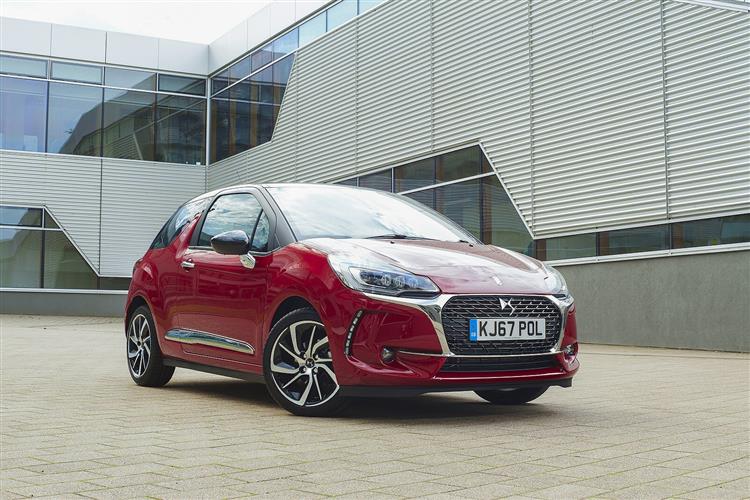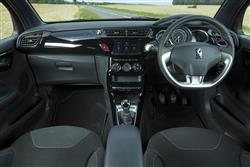How will you view?
This is a sample, showing 30 seconds of each section.
EVEN MORE DSIRABLE? (some text hidden) SECTIONED_new_ds3_2016
By Jonathan Crouch
Introductionword count: 124
The DS3 stylised performance compact hatch was first launched with Citroen badging back in 2010, then re-launched as a stand-alone DS product when DS became a brand in its own right in 2015. It's this later 'DS' DS3 that we look at here, a car that saw the brand through the next four years to the period where it could create its own bespoke designs. The change from 'Citroen' to 'DS' branding in 2015 was accompanied by a few changes, a light model refresh adding fresh engine options, more media connectivity and greater scope for individuality with both the hatch and Cabrio bodystyles. This car's fundamental fashionability though, is what really sustained sales. Even as a used car, this model still gets people talking.
Modelsword count: 16
3dr hatchback / 3dr Cabrio (1.2, 1.6 petrol, 1.6 diesel [DSign, DStyle, Dsport, Black, White, Racing])
Historyword count: 389
This DS3 was the car that rejuvenated the fortunes of its Citroen maker, following this model's original launch in 2010. Young, affluent, style-conscious customers were tempted by its blend of fashionable sporty practicality and Parisian style. In its lightly refreshed form in 2015, this design was tasked with performing a similarly pivotal role for the freshly-formed DS brand as the entry point to the company's likeable line-up. It's quite possible that you're already very familiar with this car - at least in its original form - and if so, you'll know that it's a trendy small urban trinket in the MINI or Fiat 500 mould. Or almost. The original DS3 designers certainly had their eyes on cars of that kind, but instead of copying rivals with a 'retro' look, they instead championed a fresher, more forward-thinking shape that had the added advantage of much improved practicality. It meant that DS3 owners could enjoy Sloane Street style with Sainsburys sensibility, a winning combination further developed by the launch of a Cabrio version in 2013 and the introduction of more up-to-date engineware a year later. As a result, sales momentum was maintained and by the end of 2015, over 390,000 DS3 models had been sold. By then though, things were changing. The DS concept this car had first pioneered had swiftly been extended into larger DS4 and DS5 models, these cars creating a Citroen sub-brand so successful that it was decided DS should be created as a premium auto maker in its own right. The DS4 and DS5 ranges were quickly re-styled and re-positioned within this newly-formed marque's model line-up and the DS3 followed suit early in 2016, creating the car we're going to look at here. There was more though, to this improved DS3 than merely a different badge on the bonnet. Smarter styling was complemented by the addition of two fresh engines to the line-up, including one for the kind of properly potent hot hatch variant the standard model range had previously never had. There was also more equipment, extra scope for personalisation and, inside, extra media connectivity via a smartly hi-tech 7-inch colour touchscreen. It was all just about enough to sustain the car through to the end of 2019 when a new design based on a more modern CMP2 platform, the DS3 Crossback small SUV, took over.
What You Getword count: 1013
To the uninitiated, the DS3 is still quite a sight. Yes, the basic shape is that of a traditional supermini, but it was developed with the kind of flair usually reserved for concept cars, distinctive curves marking extremities that see the wheels pushed right out to the corners, producing a squat, purposeful stance. The real drama, however, is in the detail. From the 'shark fin' B-pillar to the contrasting 'floating' roof panel and the distinct sill line connecting the wheelarches, the DS3 always remained ferociously unconventional. The move to full DS branding brought with it the opportunity to re-style the front end, where the vertical grille was changed to proudly incorporate the 'DS Wings' brand logo and extends smoothly into headlights that feature 'LED Vision' xenon technology on plusher variants. The hatch model offers a 285-litre boot that's pretty much equal in size to the space you'd get in a practical Ford Fiesta. That makes it around 35% bigger than the trunk offered by an ordinary MINI and nearly twice as large as the cargo area found in stylised rivals from this period like Fiat's 500 or Vauxhall's ADAM. Unfortunately, there's quite a high loading lip to get your stuff over before you can access it though. Enough with the practicality. On to how this car is going to make you feel when you slip behind the wheel. Pretty smug and self-satisfied we think, if you're moving into it from a conventional supermini. Plus there's the high quality cabin ambience that always marked out this DS3, with its piano black trimming and cool white lighting. The key change made as part of this model's move into full DS branding was the addition of a smart 7-inch colour touchscreen for the centre stack. It was a standard item across the range and played a significant part in de-cluttering the dash, with functionality removing no fewer than 21 buttons from the fascia. A pity though, that it can't be activated by the kind of rotary controller that rival MINI and Audi A1 models get. Otherwise, it works well, marshalling audio, telephone and 'Driving' trip computer functions, along with the eMyWay navigation system, where that's fitted. The touchscreen also enables the DS brand to offer a wide range of media connectivity 'Connected Services' in this car - not only an internet browser but also 'Mirror Screen' functionality (which was optional lower down the range) that provides access to the 'MirrorLink' and 'Apple CarPlay' systems, allowing you to duplicate the functionality of your smartphone onto this display. Accessing the rear in the three-door-only model can be a bit tricky due to the huge B-pillar and the chunky front seats, though there's a grab handle thoughtfully positioned to aid the process. Once you're in place, the actual space provided isn't too bad - at least for two people anyway, provided they're not too tall and the journey involved isn't too long. There's certainly a vast amount more space back here than you'd get in supposedly competitive models from this period like the three-door MINI Hatch, the Fiat 500, the Vauxhall ADAM and the Alfa Romeo MiTo. What's even more impressive is the room you get in the back of the Cabrio version. True, getting into the back isn't quite as easy as it would be in a full-blown soft-top like a MINI Convertible because you have to duck under the roof pillar as you would in any three-door hatchback. Once you're there though, there's an unusual bonus. As in the hatch model, there's the potential to theoretically take three passengers across the back seat. OK, so a trio of adults would be rather squashed if you tried to do that, but three small children would be fine with it. This kind of capability is unique in the small cabrio class from this period and opens up soft-top ownership to family buyers who otherwise simply wouldn't be able to consider a car of this kind. We'll finish this section with a few words on the roof of the Cabrio version. At first glance you'd be forgiven for not realising this to be a soft top variant at all. After all, the profile of this model is identical to that of its fixed-top counterpart, the fabric opening section limited to the very top of the car. Actually though, the roof mechanism is quite sophisticated, made up of over 180 different parts and electrically operated by a button on the overhead console that, impressively, can retract the roof at any speed up to 75mph. Prodding the button once will slide the canvas back so that it concertinas like a busker's accordion above a rear screen which, if you continue to press the button, will hinge forward to lie on the parcel shelf, before the folded canvas sandwich motors back to take its place. As with the folding tops provided by most rivals, you'll find that when retracted, this one almost totally blocks rearward vision - hence the Cabrio variant's standard parking sensors. The roof acrobatics take only 16s from start to finish and when the whole thing's open, there's a pop-up wind deflector that springs out of the top roof rail to quell the worst of the turbulence. Of course, when you do have the roof down, you don't want it to take up so much space at the back that there's no room for people or packages. In the DS3 Cabrio it doesn't. Take rear cargo space, accessible via a cantilevered boot lid that rises neatly outwards and upwards in a circular motion that means you can open it even when parked close to obstructions. It's unfortunate that once it is open, the aperture available is pretty small, though actually, the capacity on offer is greater than it first appears - 245-litres in all. That's 30-litres more than you'd get in a rival MINI Convertible and 63-litres more than you'd get in an equivalent Fiat 500C. Plus you can extend it by folding down the same 60/40 split-folding rear bench you'll find on the DS3 hatch, revealing up to 980-litres.
To see the full road test text contact us on 0330 0020 227
Pictures (high res disabled)

.jpg)
|
.jpg)
|
.jpg)
| |||
.jpg)
|
.jpg)
|
.jpg)
| |||

|
Scoring (subset of scores)
Category: Small Runabouts
| Performance | |
| Handling | |
| Comfort | |
| Space | |
| Styling, Build, Value, Equipment, Depreciation, Handling, Insurance and Total scores are available with our full data feed. | |



